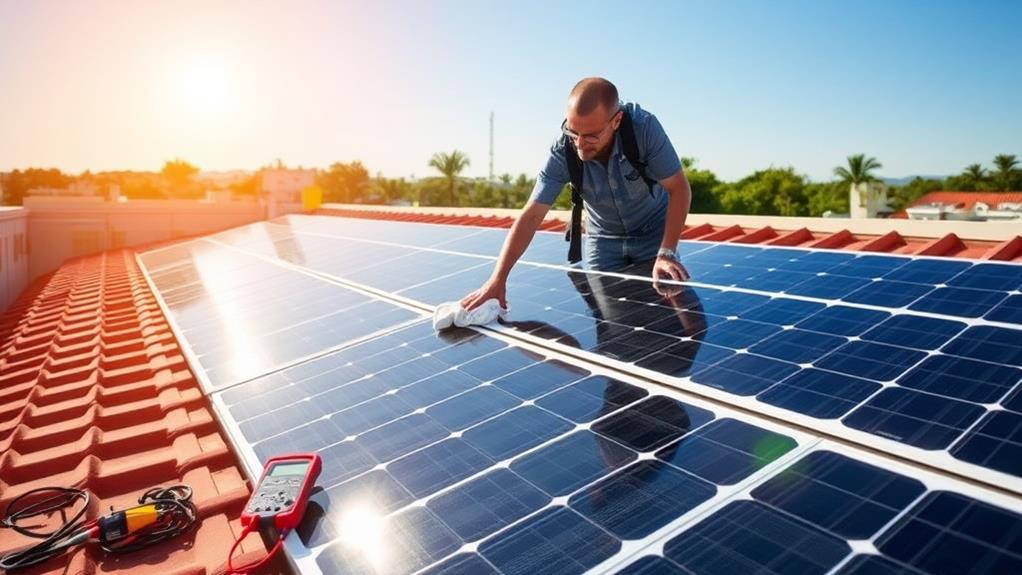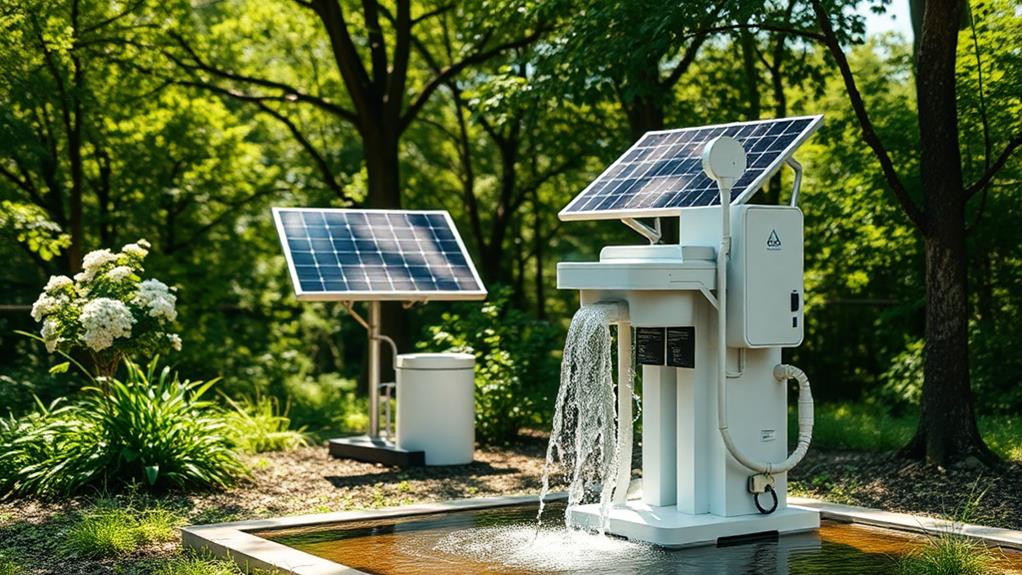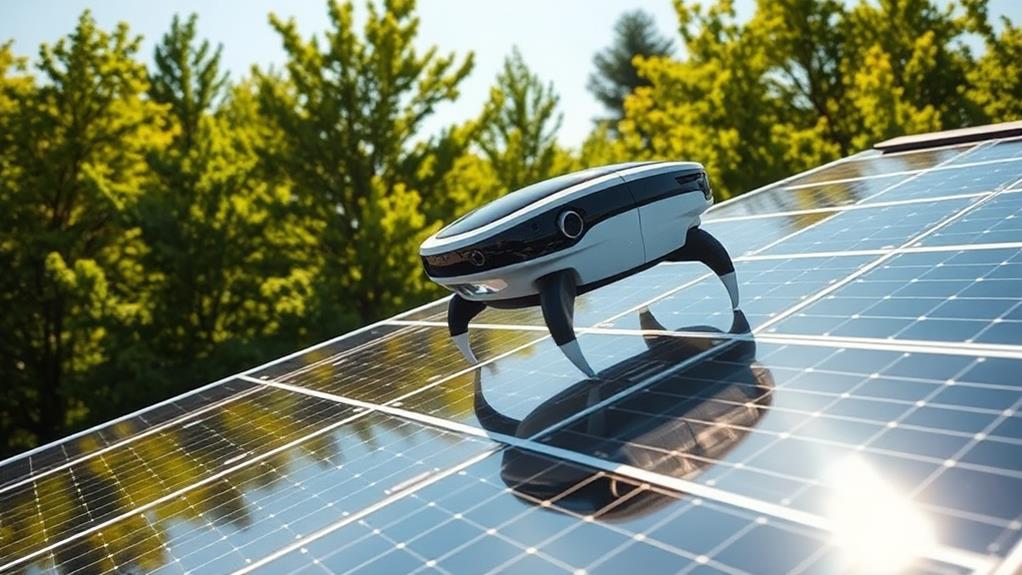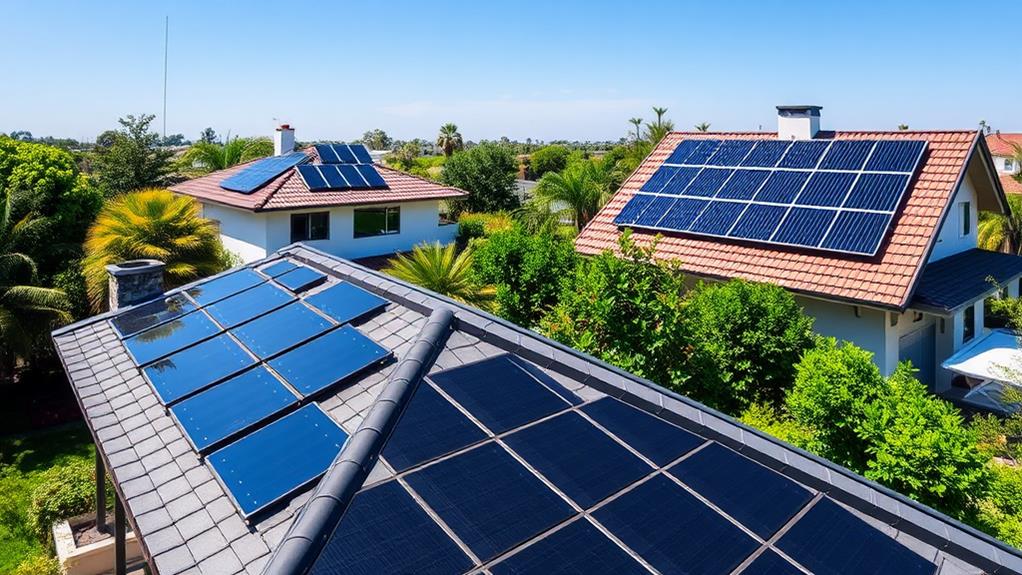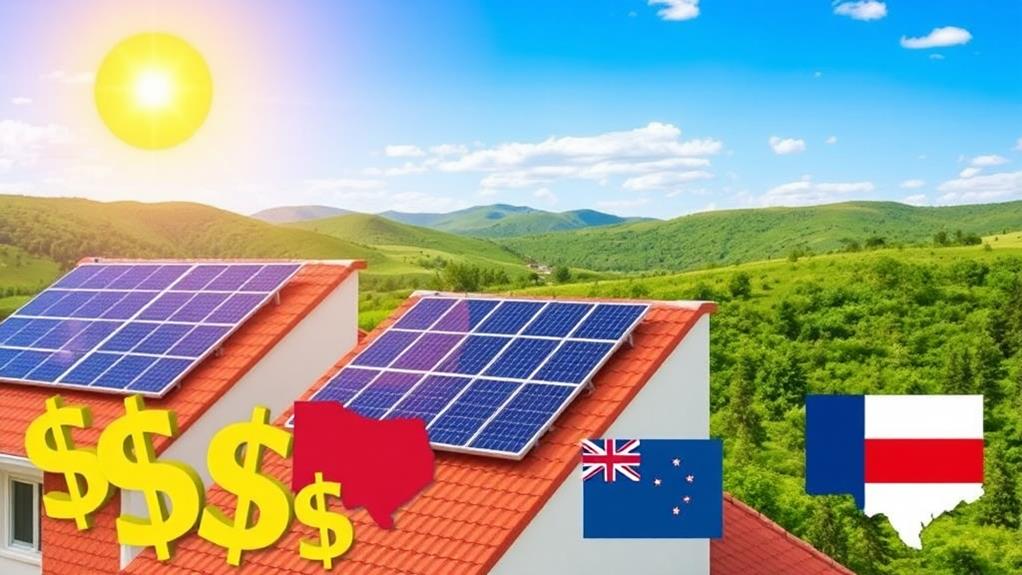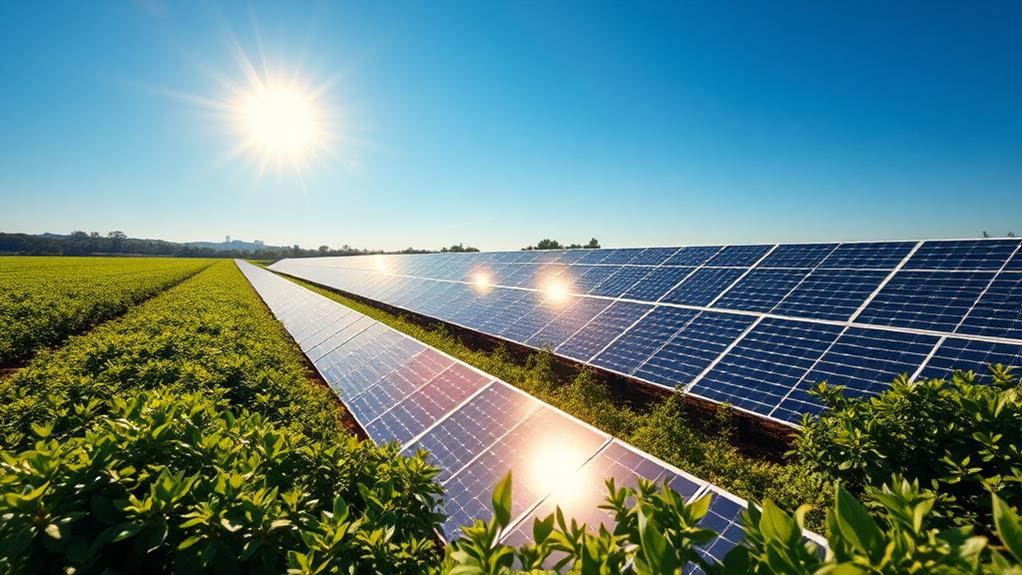To join and benefit from community solar projects, we should first identify local initiatives by researching electric utility offerings and utilizing online resources like EnergySage and the National Renewable Energy Laboratory. Eligibility generally requires residency within the utility's service area and an active electric account, with some projects considering credit scores as well. Once we've found suitable options, we need to evaluate different subscription models based on anticipated savings, which typically range from 5% to 20%. Understanding consumer protections guarantees transparency and fosters confidence in our participation. There's much more valuable information available that can help maximize our involvement.
Key Takeaways
- Research local electric utilities or online platforms to find available community solar projects in your area.
- Ensure you meet eligibility requirements, including residency and active electric meter account status.
- Compare different community solar options based on savings, billing structures, and subscription models.
- Look for projects offering at least 20% savings on electricity bills and transparent agreements.
- Contact local utilities for information on low-income programs and assistance with the subscription process.
Understanding Community Solar
Community solar projects are changing the way we think about renewable energy. These initiatives allow multiple subscribers to share the benefits of solar energy generated from large solar farms, which means we don't need to install equipment on our properties. By participating in a community solar program, we can lower our monthly electric bill through bill credits, with annual savings ranging from 5% to 20%. This option is particularly advantageous for nearly 50% of households that can't host rooftop solar systems, including many in low-income communities. Additionally, community solar projects come with consumer protections, ensuring at least 20% savings on electricity bills, transparent contracts, and no hidden fees, making it a viable path toward energy independence and sustainability for all.
How Community Solar Works

Harnessing the power of solar energy has never been easier, thanks to innovative community solar projects. In these initiatives, large solar arrays generate electricity that feeds directly into the utility grid, enabling us to benefit from renewable energy without installing panels on our properties. By opting for community solar subscriptions, we pay a monthly subscription for a share of the solar energy produced, which translates into bill credits on our utility bills. Typically, these credits help reduce our electricity costs by 5% to 20%. Each subscriber is assigned a share proportional to their electricity usage, ensuring equitable access to savings. With community solar available in at least 41 states and D.C., it offers an accessible path toward sustainable energy for all of us.
Benefits of Community Solar

The benefits of community solar projects are numerous and impactful for all of us. Engaging in community solar not only leads to significant financial benefits—offering annual savings of 5% to 20% on our electricity bills—but also provides an accessible option for renters and those unable to install their own solar panels, thanks to lower upfront costs and no installation fees. In addition, community solar enhances energy resilience during outages by ensuring backup energy options through distributed solar resources, which is crucial for our local community during adverse conditions. Moreover, these projects create local jobs, prioritizing hiring labor from within our communities and fostering economic growth. By becoming subscribers, we actively contribute to a sustainable future while reaping the rewards of clean energy.
Consumer Protections Available

Ensuring transparency and fairness, community solar projects offer several consumer protections that safeguard our interests as subscribers. These protections not only enhance our experience but also secure our financial investments. Below is a summary of key consumer protections:
| Consumer Protection | Description | Benefits |
|---|---|---|
| Minimum Savings | At least 20% off electricity bills | Significant financial benefits |
| Clear Subscription Agreements | No hidden fees, upfront disclosures | Enhanced transparency |
| Penalty-Free Cancellation | Flexibility to cancel without penalties | Peace of mind |
| Accessible Complaint Processes | Established channels for voicing concerns | Effective resolutions |
Additionally, we must check state-specific requirements, as they may provide further rights and benefits, ensuring our engagement in community solar projects is both empowering and secure.
Finding Local Community Solar

As we seek to find local community solar projects, it's crucial to research state legislation that may impact availability and eligibility criteria. We can utilize online resources, such as the National Renewable Energy Laboratory and Community Solar Marketplace, to locate relevant offerings tailored to our geographic area. Additionally, contacting local utilities can provide us with specific information on community solar initiatives within their service territories, ensuring we have a thorough understanding of our options.
Research State Legislation
With at least 41 states and D.C. hosting operational community solar projects, we have a wealth of options to explore when looking for local subscriptions. By investigating state-specific legislation, we can identify which 22 states and D.C. have enacted enabling laws that facilitate the development of community solar projects. This research is essential, as it reveals opportunities for shared solar initiatives. In addition, many local electric utilities provide information about available community solar subscriptions, making it important to check their websites or contact them directly. For those interested in low-income community solar, it's worth noting that 19 states and D.C. actively promote legislation designed to enhance access for low and moderate-income households, ensuring equitable participation in energy generation.
Utilize Online Resources
Finding local community solar projects is easier than ever, thanks to a variety of online resources at our fingertips. We can explore the National Renewable Energy Laboratory's website for listings of available projects across states and territories. The EnergySage platform allows us to compare community solar options based on estimated savings, eligibility requirements, and terms, ensuring we find the best fit for our needs. Additionally, the Community Solar Marketplace provides an updated list of open projects, helping us identify subscription opportunities in our area. Our local electric utility websites often have detailed information on community solar subscriptions, while advocacy organizations like Solar United Neighbors offer valuable educational resources to assist us in maneuvering through these options effectively.
Contact Local Utilities
Reaching out to our local utility company is a crucial step in discovering community solar projects available in our area. These companies often serve as key resources, providing information on subscriptions and benefits tailored to our needs. To maximize our chances of finding a suitable program, we should consider the following steps:
- Contact our utility provider to inquire about existing community solar projects and their eligibility requirements.
- Request information about any state-specific programs that may offer low-income community solar options, enhancing accessibility.
- Utilize customer service representatives for assistance with the subscription process, ensuring we fully understand the benefits available.
Eligibility Requirements for Participation

When considering participation in community solar projects, it's essential that we comprehend the specific eligibility requirements that govern our access to these initiatives. This includes ensuring we reside within the utility service territory of the solar farm, maintaining an active electric meter account, and meeting any applicable credit score criteria, which can vary among programs. Additionally, we should keep in mind the geographic availability of projects and the potential for reserved capacity for low- and moderate-income households, all of which play an important role in determining our ability to subscribe.
Subscription Criteria Overview
In today's energy landscape, understanding the eligibility requirements for community solar projects is essential for those looking to participate. To subscribe to a solar initiative, we should keep in mind a few key criteria:
- Residency: We must reside within the utility service territory where the community solar project is located, as participation is limited to specific regions.
- Direct Electric Bill: Subscribers typically need a direct electric bill payment account, which can complicate eligibility for renters, given potential landlord restrictions.
- Credit Score: While some community solar providers impose credit score requirements, many initiatives aim to support low- and moderate-income households by reserving a portion of capacity, promoting equitable access to the energy produced.
Understanding these factors can help us navigate the subscription process effectively.
Credit Score Considerations
Credit scores play an essential role in determining eligibility for community solar projects, impacting our ability to participate. Generally, a credit score of 650 or higher is required for many programs, but some initiatives accommodate those with scores as low as 580. It's vital for us to check the specific eligible criteria for each project, as these requirements can vary greatly by state and provider. Furthermore, alternative verification methods may be available for potential subscribers lacking traditional credit histories; for instance, utility payment histories or income verification can sometimes be used. Maintaining a good credit score not only enhances our participation opportunities but can also lead to better subscription rates and considerable savings over time.
Geographic Availability Factors
Across the United States, community solar projects have become increasingly accessible, but geographic availability is a significant factor for participation. To engage meaningfully with these initiatives, we should consider the following:
- Utility Service Territory: We must have an active electric meter account within the utility service territory of the community solar project online.
- Project Capacity: It's important to verify whether there are open projects in our area, as capacity limitations can restrict participation, even in states with programs.
- Support for Low-Income Households: Many community solar initiatives prioritize low-income households, reserving at least 40% of project capacity for these communities, which is fundamental for equitable energy systems.
Comparing Community Solar Options

When we're looking at community solar options, it's crucial to identify projects that can deliver at least a 20% savings on our electricity bills, as this benchmark is widely recognized across many states. We should evaluate various community solar providers to compare their offerings, focusing on estimated savings and billing structures. Some projects provide consolidated billing, which simplifies our payment process and tracking of savings. Additionally, we need to understand the subscription models available; some allow us to purchase shares of a community solar farm, while others only offer subscriptions for solar power credits. Finally, we must pay attention to state-specific policies and incentives that can greatly affect project availability and benefits, as 19 states and D.C. have supportive programs.
Steps to Join a Project

Once we've assessed the various community solar options, we can move forward by exploring the steps to join a project. Here's how we can navigate the process effectively:
- Research Available Projects: We should begin by checking local electric utilities or online resources to identify community solar subscriptions in our service area, ensuring we grasp eligibility criteria related to our electric bill account.
- Evaluate Subscription Models: We must review the various subscription models, whether it's a discounted rate or ownership shares, to determine which aligns with our financial goals.
- Understand the Terms: Before we subscribe, let's thoroughly examine disclosure documents for details about estimated savings, consumer protections, and any possible hidden fees to avoid unpleasant surprises.
Frequently Asked Questions
Is Joining a Community Solar Farm a Good Idea?
Did you know that community solar projects can save us 5% to 20% on electricity bills? With low costs, easy participation, and strong sustainability incentives, we can enjoy significant community solar advantages while promoting accessibility and impact.
Who Benefits From Community Solar?
Community solar benefits us all, offering renewable energy access with shared savings while boosting the local economy. We enhance community engagement and education, creating a positive environmental impact that empowers everyone to embrace a sustainable future together.
How Do Community Solar Owners Make Money?
Like a sun rising, we harness multiple revenue streams through ownership models, project partnerships, and tax incentives. By tapping into solar credits, we boost investment returns, drive cost savings, and invigorate local economies together.
What Is the Downside to Community Solar?
When considering community solar, we must weigh cost considerations against limited availability and regulatory challenges. Subscriber commitments can limit our freedom, while financial incentives may not guarantee substantial energy savings or project legitimacy for everyone.


